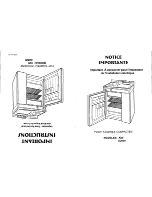
·
Use special Freezer bags available from supermarkets, Freezer film, polythene bags, plastic containers, aluminum foil for
acidic foods(such as citrus fruits).
Do not use thin cling film or glass. Do not use used food containers (unless cleaned thoroughly first).
·
Exclude as much air from the container as possible. You could buy a special vacuum pump which sucks excessive air out
of the packaging.
·
Leave a small amount of “air space” when freezing liquids, to allow for expansion.
·
You can use the space in the Freezer most efficiently if you freeze liquids(or solids with liquids, such as stew) in square
blocks.
This is known as “performing” Pour the liquid into a polythene bag which is inside a square sided container. Freeze it like
this, then remove it from the container and seal the bag.
Recommended storage periods
For recommended food storage time, refer to the information given on your food packaging.
DEFROSTING
Defrosting
After a period of time frost will build up in certain areas in the Fridge/Freezer compartment. As a temporary measure, this
frost should be scraped away using a plastic scraper. NEVER use a metal or sharp instrument. Complete defrosting will
however become necessary approximately once per year, or if the frost layer exceeds 5mm to maintain the efficiency of
the Fridge/Freezer. This should be carried out if the frost build-up cannot be scraped away, or if it begins to interfere with
the food storage. Chose a time when the stock of frozen food is low and proceed as follow:
1.
Take out the frozen food, turn the Fridge/Freezer off at the mains supply and leave the doors open. Ideally the frozen
food should be put into another Fridge/Freezer or refrigerator. If this is not possible wrap the food, firstly in several
sheets of newspaper or large towels and then in a thick rug or blanket and keep it in a cool place.
2.
Scrape away as much frost build-up as possible using the plastic scraper. To accelerate the thawing process place
bowls of hot water inside the Fridge/Freezer cabinet. As the solid frost loosens, prize it away with the plastic scraper
and remove.
3.
After defrosting, Please clean the water in water tray(located on top of compressor) in time. Then clean your
Fridge/Freezer as described.
Cleaning inside the Fridge/Freezer
After defrosting you should clean the Fridge/Freezer internally with a weak solution of bicarbonate of soda. Then rinse
with warm water using a damp sponge or cloth and wipe dry. Wash the baskets in warm soapy water and ensure they are
completely dry before replacing in the Fridge/Freezer. Condensation will form on the back wall of the Fridge; however it
will normally run down the back wall and into the drain hole behind the salad bin.
The drain hole will have a “cleaning spike” inserted into it. This ensures that small pieces off food can not enter the drain.
After you have cleaned the inside of your Fridge and removed any food residues from around the whole, use the “cleaning
spike” to make sure that there are no blockages.
Cleaning outside the Fridge/Freezer
Use standard non-abrasive detergent diluted in warm water to clean the Fridge/Freezer exterior.
The grille of the condenser at the back of the Fridge/Freezer and the adjacent components can be vacuumed using a soft
brush attachment.
Do not use harsh cleaners, scouring pads or solvents to clean any part of the Fridge/Freezer
TROUBLESHOOTING AND MAINTENANCE
Trouble Shooting
Power cut
If the internal temperature of the Fridge/Freezer compartment is -18
℃
or less when the power returns, your food is safe.
The food in your Fridge/Freezer will remain frozen for approx 16 hours with the door closed. Do not open the
Fridge/Freezer door more than necessary.
The Fridge/Freezer is exceptionally cold
You may have accidentally adjusted the thermostat control dial to a higher position.
The Fridge/Freezer is exceptionally warm
The compressor may not be working. Turn the thermostat control dial to the maximum setting and wait a few minutes. If
there is no humming noise, it is not working. Contact the local store where your purchase was made.
The Fridge/Freezer is not working
Check it is plugged in and switched on. Check that the fuse in the plug has not blown. Plug
In another appliance, such as a lamp, to see if the socket is working. The Fridge/Freezer should be placed in a well
ventilated room. Leave the Fridge/Freezer for 30 minutes.
Condensation appears on the outside of the Fridge/Freezer
This may be due to a change in the room temperature. Wipe off any residue of moisture. If the problem continues contact
the local store where your purchase was made.
GURGLING, WHOOSHING
These noises are caused by the circulation of the refrigerant liquid in the cooling system. It has become more pronounced
since the introduction of CFC free gases. This is not a fault and will not affect the performance of your Fridge/Freezer.
HUMMING, PURRING OR PULSATING
This is the compressor motor working, as it pumps the refrigerant around the system.
Moving the Fridge/Freezer
Location
Do not place your Fridge/Freezer near a heat source, eg. Cooker, boiler or radiator. Also avoid direct sunlight in
out-buildings or sun lounges.
Leveling the Fridge/Freezer
Make sure the Fridge/Freezer is level. Use the rotating leveling feet at the front. If the Fridge/Freezer is not level, the
















































